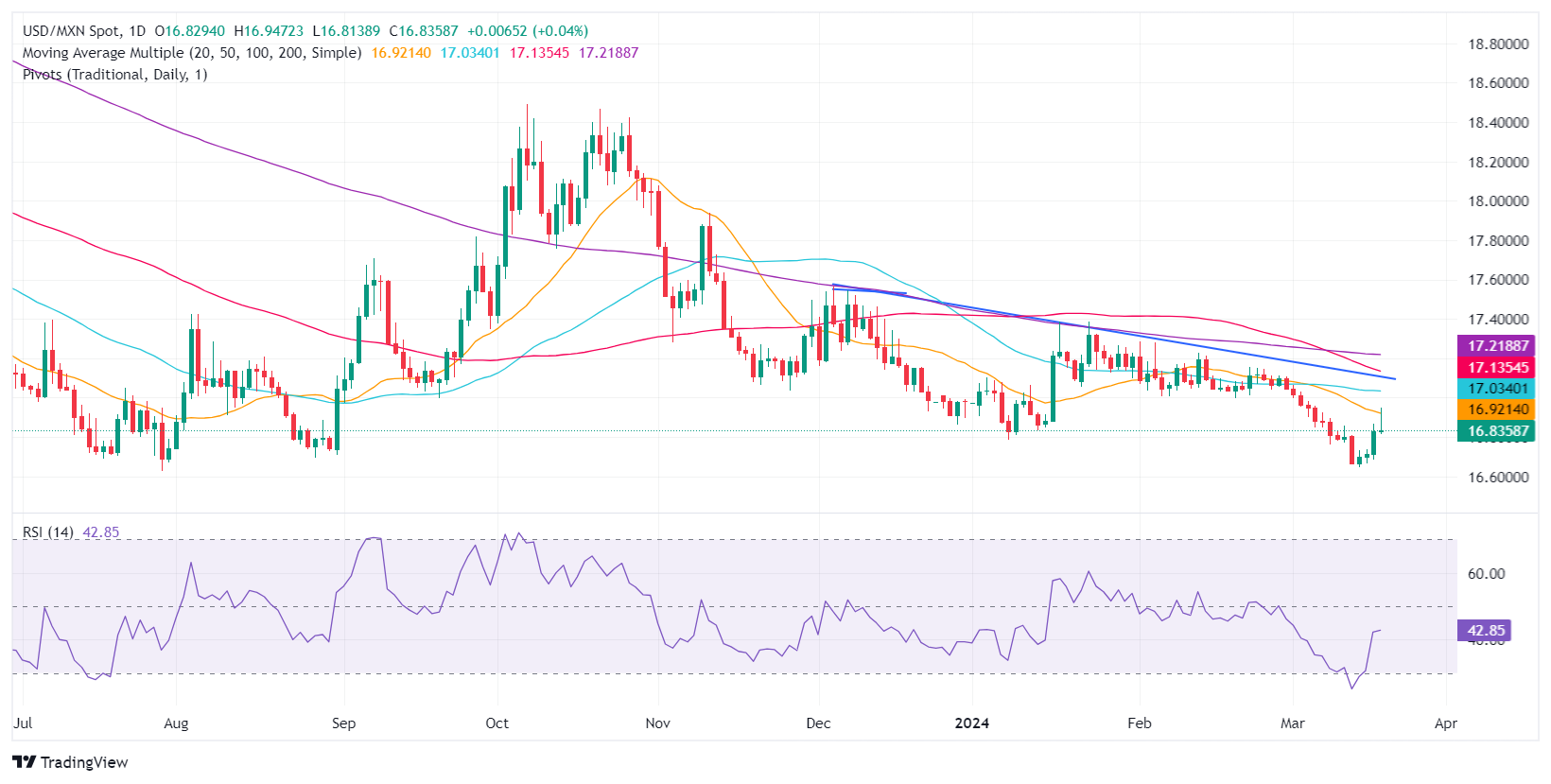Mexican Peso trims losses against US Dollar after solid US housing data

- Mexican Peso weakens in early North American trading as US Dollar gains strength.
- Mexican data is mixed though the economy finished 2023 on a higher note.
- Central bank divergence between Fed and Banxico could bolster USD/MXN pair.
The Mexican Peso depreciated in early trading during the North American session as the US Dollar climbed some 0.25%, based on the US Dollar Index (DXY). Speculation that the Bank of Mexico (Banxico) would ease policy on Thursday grew, while traders continued to trim odds for the Federal Reserve’s first rate cut. The USD/MXN trades at 16.83, clocking a gain of 0.08%.
Mexico’s economic docket featured the release of Aggregate Demand and Private Spending, with both figures exceeding Q3 2023 readings, suggesting the economy ended the year on a higher note. Across the border, US housing data exceeded estimates and improved compared to January’s data, and now all heads turn toward the Federal Open Market Committee (FOMC) decision on Wednesday.
Daily digest market movers: Mexican Peso on defensive amid dovish Banxico
- Estimates that Banxico will lower the interest rate from 11.25% to 11% puts “some” pressure on the Mexican currency, which could lift the USD/MXN toward the 17.00 mark.
- Mexico’s economic data released on Tuesday:
- Aggregate Demand rose by 0.3% QoQ in Q4, up from 0%. On an annual basis decelerated from 2.7% to 2.6%.
- Private Spending on a quarterly basis slowed from 1.2% to 0.9%. On a yearly basis, it improved from 4.3% to 5.1%.
- The USD/MXN is being driven by the reduction of interest rate spreads between Mexico and the United States. This could bolster and set the USD/MXN direction toward the 17.00 figure.
- On March 21, Banxico is expected to decrease interest rates, even though it could feature a 3-2 vote split. Recent speeches and media appearances show that Banxico’s Governing Council is divided, with Governor Victoria Rodriguez Ceja, Omar Mejia Castelazo and Galia Borja Gomez leaning dovish. On the hawkish front lie Jonathan Heath and Irene Espinosa Cantellano.
- An economic slowdown in Mexico is the main event that could spark Banxico’s first rate cut as the central bank has adjusted its economic projections to the downside. Mexico’s central bank expects the economy to grow 2.8% YoY in 2024, down from 3% and maintaining at 1.5% for 2025.
- US Building Permits in February rose 1.9% from 1.495 million to 1.518 million, suggesting that demand continues to increase.
- Housing Starts increased by 10.7% compared to January’s data as starts jumped from 1.425 million to 1.521 million.
- The latest inflation figures in the United States prompted investors to price in a less dovish stance. Money market futures had adjusted their rate cut expectations more in line with the Fed as they foresee the Federal Funds Rate (FFR) at 4.71% toward year end. The next Fed meeting is scheduled for March 19-20 next week, and analysts estimate no change to its Federal Funds Rates (FFR).
Technical analysis: Mexican Peso begins to weaken as USD/MXN aims above 16.80
The USD/MXN has shifted to a neutral bias as buyers stepped in and lifted the exchange rate above the January 8 swing low of 16.78. After breaching that level, the pair clocked a new two-week high of 16.94, though buyers are taking a breather before launching an assault toward 17.00. Once that hurdle is overcome, the next resistance would be the 50-day Simple Moving Average (SMA) at 17.02, followed by the 100-day SMA at 17.16 and the 200-day SMA at 17.21.
On the flip side, the exotic pair must drop below 16.80, which could pave the way for a test of last year’s low of 16.62, followed by October 2015’s low of 16.32 and the 16.00 psychological level.
USD/MXN Price Action – Daily Chart
Banxico FAQs
The Bank of Mexico, also known as Banxico, is the country’s central bank. Its mission is to preserve the value of Mexico’s currency, the Mexican Peso (MXN), and to set the monetary policy. To this end, its main objective is to maintain low and stable inflation within target levels – at or close to its target of 3%, the midpoint in a tolerance band of between 2% and 4%.
The main tool of the Banxico to guide monetary policy is by setting interest rates. When inflation is above target, the bank will attempt to tame it by raising rates, making it more expensive for households and businesses to borrow money and thus cooling the economy. Higher interest rates are generally positive for the Mexican Peso (MXN) as they lead to higher yields, making the country a more attractive place for investors. On the contrary, lower interest rates tend to weaken MXN. The rate differential with the USD, or how the Banxico is expected to set interest rates compared with the US Federal Reserve (Fed), is a key factor.
Banxico meets eight times a year, and its monetary policy is greatly influenced by decisions of the US Federal Reserve (Fed). Therefore, the central bank’s decision-making committee usually gathers a week after the Fed. In doing so, Banxico reacts and sometimes anticipates monetary policy measures set by the Federal Reserve. For example, after the Covid-19 pandemic, before the Fed raised rates, Banxico did it first in an attempt to diminish the chances of a substantial depreciation of the Mexican Peso (MXN) and to prevent capital outflows that could destabilize the country.
